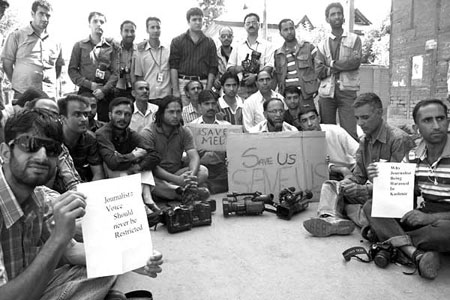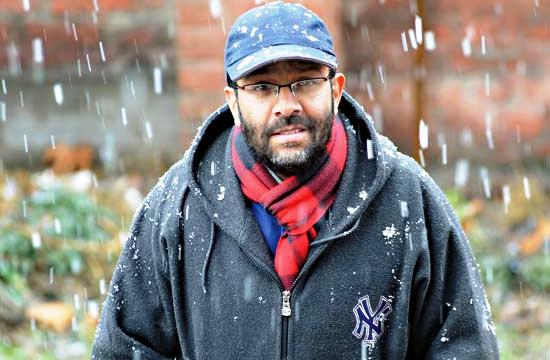Photo and video journalists bring news into the bedrooms and are always perceived by people as a glamorous lot. Izhar A Wani writes about the risks and the grit needed to report from conflict areas like Kashmir.

When a murky militant group interrogated me and my photographer, Tauseef Mustafa, during a simulation exercise that was part of a week-long hostile environment training course in Hongkong a few months ago, other AFP (Agence France Presse) colleagues from across the world at the programme had their hearts in their mouths – almost.
We also raced through riot situations, embarrassing roadside checkpoints, life-threatening gun battles, dodging sniper fire all with heavy protective gear. It was something new for our colleagues who were being prepared to report in dangerous situations but Tauseef and I had dealt with such situations while covering stories in Kashmir.
The training, no doubt, was very useful but it reminded me of some of my photojournalist (and videographers) colleagues back home who have no big organisations to fund such trips, no money to buy expensive protective gear and who despite all odds continue to cover the Kashmir story and win appreciation.
People always discuss and debate incidents, the pictures of which are brought right into their drawing rooms, but rarely come to know what the lensmen, who cover such events, go through.

Kashmir valley’s daring news photographers and videographers deserve all the credit for recording the scenic region’s most turbulent times, risking their lives to show to their own people and the outside world the day to day events linked to the ongoing two-decades-old separatist uprising.
Talking to them is always a humbling reminder of what most of them put themselves through to get to the story. And when we talk of fair and fearless coverage of events in Jammu and Kashmir, the name of Meraj-u-Din is the first to come to mind.
Din’s career spans over three decades. He has had several close shaves with death but his determination and dedication towards the profession never showed signs of flagging.
“Fear has no place in our profession. Despite intimidation, repeated thrashings and frequent threats, I never thought of leaving this profession,” says Din, region’s leading videographer and the state head of US-based Associated Press Television Network (APTN).
At the start of the insurgency, he and his close associate Habib Ullah Naqash, were even detained and questioned by the Border Security Force (BSF), the main force that was battling the militants then.
“They (BSF) were under the impression that we knew where the militant commanders were. But that was not true and they let us go,” says Din. He said intelligence sleuths used to follow him where ever he went for coverage during the two-month bitter conflict between government troops and Pakistan-backed intruders in Kargil and Drass in 1999.
Din survived intense shelling by Pakistanis during the conflict. Ignoring dangers to his life, he used to shoot nonstop, at times spending nights in abandoned mud houses littered with goat droppings.
Like Din, S Tariq, a videographer for NDTV, is another journalist who earned a name for his daring coverage of the events.
In 1990, he was beaten black and blue by police while covering an anti-government demonstration in Srinagar for leading Urdu daily Aftab. He kept on shooting until pain overtook him and doctors later diagnosed a fractured leg.
Tariq says twenty years on, nothing has changed for them. “Getting beaten-up has become part of our profession. We are targeted by both sides. Our presence irks police. Protestors accuse us of selling the footage to the security forces,” says the burly Tariq, whose beard is now tinged with grey.
“There may be some black sheep among us. We need to sit down and sort these matters,” he said, referring to the accusations.
“No story is worth your life,” is the frequently heard chant by our editors as we rush to cover a violent incident. But our photo and video colleagues throw care to the wind to capture the action.
In 1996 Din and Tauseef were part of over two dozen journalists waylaid by a pro-government militant group as they headed for a press conference of the chief commander of another pro-government militant group. As the army stormed the building where they were being held by their captors, the pair chose to shoot the rescue without caring for their lives.
Years later the two continue to risk their lives.
Tauseef, who has also served in Iraq and Afghanistan, was mercilessly beaten up in Sopore by police and CRPF in 2008 as he and a few of his colleagues were covering a small anti-election protest.
“They pounced on us without any reason,” says Tauseef, who just a few months before the incident was struck in the head by a stone during a violent protest and had to be hospitalised.
“Ever since I joined this profession in the mid-1990s, we have always been targeted by all sides particularly by the police,” says Tauseef, as he hurriedly put on his riot vest and grabbed a teargas mask to cover yet another protest.
Every photographer’s story is a tale of courage.
Young Irfan Manzoor of Zee TV was badly hurt in a bomb explosion on August 10, 2000, that also left Pradeep Bhatia -a New Delhi based photographer of Hindustan Times – dead.
After months of specialised treatment in New Delhi, Manzoor returned to Kashmir to do what he does best – shooting with his camera.

All that hard work has not gone unnoticed. From Din to Tauseef Mustafa of AFP to Reuter’s Fayaz Kabli and AP’s Yasin Dar, many of our photo and videographers have won prestigious international awards for their outstanding work. But all that great work and appreciation has come at a price – intimidation, being roughed up by security forces and even by angry protesters or mourners, often beaten up badly and harassed. Aman Farooq of Greater Kashmir newspaper almost lost his life after being allegedly fired upon by a police officer this January at the end of a two-day hotel siege in Srinagar. The incident sparked spontaneous protests and condemnations.
Aman is now back at work. A bandaged thigh is evidence of his ordeal but his spirits are high.
“This is the place where I belong,” he said of Press Enclave, where most lensmen huddle together over a cup of tea or wait for hours before setting out on assignments.
“They can’t break my will to cover Kashmir for my newspaper,” asserts Aman, the kind of guy who embodies the phrase “hard as nails.” Photo-journalists never interfere in the working of the security forces, says Aman. “But still we are perceived as trouble makers.”
Aman’s photo chief Habib Ullah Naqash, who also works for The Asian Age newspaper, agrees. Naqash, known for his artistic photography, survived a parcel bomb explosion at the local BBC office in September 1995 that killed his close friend and colleague Mushtaq Ali, who used to supply video footage to Asian News International and photos to AFP. Another survivor was BBC correspondent Yusuf Jameel.
“It was a miraculous escape for both of us. It shattered me as I lost my friend but it also made me determined to cover Kashmir more fearlessly,” says Naqash.
Another journalist determined not to give up is Farooq Khan presently working for the European Press Agency (EPA) after having served national newspapers like The Pioneer and The Hindustan Times. Khan is also the photo chief for a local English daily, The Rising Kashmir.
He has been hurt umpteen times while covering the incidents like fidayeen attacks, gun battles, bomb explosions and violent street protests. Despite injuries – the count of which he has lost – quitting has never been an option.
“I know I am in a high-risk job but I love taking pictures and can’t survive without photography,” says ever-smiling Khan, who in mid-2000 sustained a splinter injury as he got down and crawled on his knees to cover an attack on Congress headquarters in Srinagar.
Though separatist violence has shown a remarkable decline since India and Pakistan started a peace process in 2004, Khan believes the challenges for photographers have only increased.
Kashmir valley has been in the grip of frequent anti-government protests since mid-2008 when a row over the donation of government land to Shri Amarnath Shrine Board sparked major pro-freedom demonstrations.
The protests have often turned violent either because they are blocked by the police or some from the crowd hurling brickbats and stones.
“These are really difficult times. We are targeted by the police as they accuse us of provoking protesters,” says Khan.
And at times, it is the crowd that targets them – accusing photographers and videographers of providing snaps and footage to police that helps them to identify the stone pelters.
Meraj-u-Din says people regularly monitor news and photos on the TV, internet, newspapers and magazines.
“If they are not convinced with a particular coverage, they target us. The reaction ranges from verbal abuse to physical beating,” complains Din, adding even some among the demonstrators object to the presence of photo and videographers, making it difficult to shoot an important protest.

Din injured his left eye while covering a violent street protest in 1984 and has lost 85 per cent of vision in that eye.
Kashmiri lensmen at times spend days together near encounter sites. They shoot pictures and intermittently update their journalist colleagues, who often report the events from their respective bureaus. The writers only rush to the scenes once advised by their photo and video colleagues about the magnitude of the event.
“They are our eyes and ears. They are always at the forefront and often bear the brunt of the situation,” says Sheikh Mushtaq, bureau chief of Reuters news agency in Jammu and Kashmir.
(The author is the Bureau Chief of international news agency AFP)















